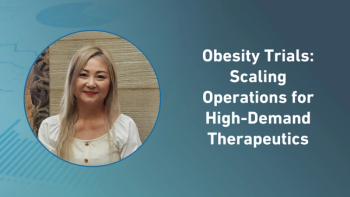
Shortening Clinical Drug Supply Timelines Using AI
AI can also help reduce waste from 70% to 25%.
There are many complexities leading to uncertainty throughout the clinical trial supply chain. On the demand side, there is unpredictability in the forecasted patient recruitment. There is, for example, a lack of pre-emptive knowledge of the sites where patients arrive, how many patients are arriving at each site, the associated treatment for these patients. Furthermore, this uncertainty persists in later trial phases for instance on an individual treatment level due to the unpredictability on how a patient will react to a treatment, the optimal dosage for a given patient and how to accommodate for different ages or weight ranges being accounted for throughout the trial. All of these outstanding questions lead to pressure on the clinical supply chain, since it is crucial to accurately forecast the amount of drugs needed to be produced and distributed in order to avoid running out of stock, or struggling with urgent delivery needs, while also maintaining a lean system.
The pharmaceutical industry is facing global challenges, resulting in a constant need for change and adaptation to be efficient and successful. Within the past five years the industry dealt with the impact of Brexit, continuously changing regulations, the COVID-19 pandemic, and geopolitical conflicts to name a few. These companies had to adapt their global supply chain strategy to ensure that all active patients were receiving continuous treatment, regardless of the surrounding turmoil. On top of this unforeseen unpredictability, the pharmaceutical companies are switching to more biotechnology-driven drugs which decreases the already tight expiry constraints.
Shorter timelines and less drug waste
Ultimately, the benefit of streamlining the clinical trial supply chain is the decrease of global waste in clinical developments (i.e. drug waste and reduced distribution needs). With Environmental, Social and Governance (ESG) becoming more crucial in the industries’ day-to-day activities, being more efficient on the clinical supply chain is one essential element for pharma and biotech companies to achieve their ESG goals.
Biotech and pharmaceutical companies can maximally leverage data and artificial intelligence in order to tackle this uncertainty. Identifying the right software technologies to centralize, optimize, and exchange data seamlessly is the first step in successfully fulfilling the supply chain ambitions. The end-to-end clinical supply chain consists of numerous steps, emphasizing the need for a successful strategy that provides global visibility on various performance levels. It is helpful to rely on both an accurate demand forecasting solution (i.e. to best handle the uncertainty coming from the clinical operations) and an efficient supply planning system (i.e. to translate the clinical demand into supply chain decisions to manage production and distribution plans at each step of the end-to-end supply chain, from drug substance manufacturing down to investigational site inventories management).
There are two phases during which the trial can be influenced: firstly, before the start of the trial. This first stage, also known as the protocol design of a trial, strongly impacts the required clinical planning and its related predictability and uncertainty. At this early stage, planning the clinical trial supplies is mainly about aligning the supply chain needs of sites (i.e. through the set-up of an IRT/RTMS system for most Phase II and III trials) and depots with the IMP (i.e. finished product) release plan. Additionally, it could be beneficial to create a scenario comparison to anticipate potential trial evolutions.
Secondly, during the trial to stay proactive in adapting to potential change. The ability to re-evaluate clinical demand in a smart and dynamic way requires the use of various information sources (e.g. from the investigational sites, the depots, the packaging sites). Leveraging this data through AI and machine learning techniques will help the clinical supply manager in pinpointing the potential sources of risk surrounding supplies and potential bottlenecks. Additionally, this will help highlight opportunities to adapt the clinical supply chain strategy to better cope with the current trial evolution. This use of efficient technology is intended to provide more control for the supply chain manager, less risk for the patients, and less waste/reduced budget for the trial.
It is common practice for pharmaceutical companies to ensure patient safety and proper dosing by overproducing, overstocking and overdistributing. In other words, they create large buffers of drug kits, knowing that most of these kits would expire before use.In our talks with pharmaceutical and biotechnology R&D excessive waste is acknowledged, and strategies are developed to minimize waste.
Based on our own research, pharmaceutical and biotech companies tend to waste, on average, 70% of the total drugs that they produce.1 This total drug waste is costing the pharma and biotech companies millions of dollars per year or hundreds of millions for Top 10 companies (i.e. 30 to 40% of the drug supplies budget before optimization). More importantly, this large amount of drug waste can lead to inability for biotech companies to accelerate their clinical development pipeline due to supply constraints, therefore inhibiting further innovation. To mitigate this issue in the short term, biotech companies are trying to increase their manufacturing capabilities (e.g. through new contracts with CMOs). However, this method of achieving increased supply in the short term is simply an “easy fix” without accounting for long term sustainability and mitigation of drug waste.
Biotech organizations are now investing in efficient supply chain planning systems, powered by AI technology, to handle the specific needs of clinical development. They can reduce waste roughly by 50%, using AI which is incorporated in a reliable clinical supply planning system, leading to a total waste being 25%2 instead of the original 70%.1 By decreasing waste, pharma and biotech companies can treat two or three times more patients, by reallocating drug manufacturing slots to other drug product demands, by accelerating patient recruitment or advancing new studies. By increasing the rate at which kits are allocated, this can lead to more accurate distribution, and increased access to patients; all ultimately leading to a shorter NDA filing and FDA approval. It is fascinating to envision how a lean supply chain, powered with AI technology, can accelerate clinical developments by as much as two to six months—depending on programs and therapeutic areas.
Data visualization and AI
The adoption of new technology takes time and change management. On average, it will take two to three years for a biotech company to achieve maximum benefit from AI and automation. To begin the process, an assessment of digital maturity needs to be done—this can lead to potential process and/or structural adaptation. By starting with an assessment of the current supply chain threshold, pharmaceutical and biotech organizations can better understand the potential positive impact of AI on their daily operations and compare this transformation over time. To achieve maximum benefit, clinical supply chain managers must learn to effectively input their data and expertise within an advanced forecasting & optimization software3 and then trust the technology to help them in their day-to-day activities. Clear dashboards give a visual picture on the robustness of the supply chain strategy. Supply chain managers can observe that the forecasts provided by the software are accurate and that the automation is, in fact, helping them to optimize their previously standardized process.
It is evident that throughout an individual trial lifecycle there will be changes that affect the accuracy of the predictions. For example, if the number of patients for one country suddenly increases, the risk of out-of-stock increases since that need was not planned for in advance. Fortunately, the real-time monitoring dashboards will indicate this immediately.4 The supply chain manager will get a specific alert, allowing him/her to proactively adapt the supply chain plan (e.g. with a suggested resupply to the specific depot, 2 weeks earlier than previously planned) and avoiding any risk for patients to get their treatment on time. These insights can then be communicated across teams to streamline the entire drug development process and steer data-driven communication.
Based on my experience, the most important prerequisite for trusting AI is to avoid the so-called “black box effect.” Unless the added value of artificial intelligence can be visualized, the needs for utilization may be perceived as too high. However, by implementing this technology, clinical supply chain planners can understand how the mathematical models behind AI can increasingly support them in their daily work, bringing both proactivity and efficiency in their supply chain. This will help all parties involved in the supply chain operations trust the technology and use it to improve their planning, which ultimately leads to making better global decisions.
In summary, as clinical trials and clinical developments become more complex, decentralized, and patient-centric, pharma and biotech companies need to leverage data and automation to handle the increased pressure. Technology is opening new doors, allowing them to reduce drug development time, waste, and costs, while making communication and clinical supply chain managers’ life easier. Ultimately, this all leads to the greatest impact—patients benefiting from faster and more efficient treatment.
Sébastien Coppe, PhD, Life Sciences Vice President, N-SIDE
References
- N-SIDE retrospective analysis performed on over 900 trials that ended before 2022, managed without optimization from 5 Top 30 pharma companies
- N-SIDE analysis performed on over 1,100 trials across all indications from 20+ pharma companies, optimized with N-SIDE from 2017 to 2022.
- The
N-SIDE Suite provides end-to-end clinical supply chain forecasting and optimization, leveraging AI techniques to turn clinical data into actionable insights. - N-SIDE
case study “G o beyond forecasting with real-time monitoring” , N-SIDEwhite paper “Sanofi improves clinical trial monitoring with N-SIDE Suite for ClinicalTrials”
Newsletter
Stay current in clinical research with Applied Clinical Trials, providing expert insights, regulatory updates, and practical strategies for successful clinical trial design and execution.




